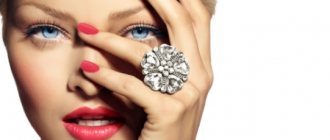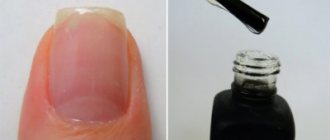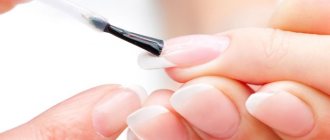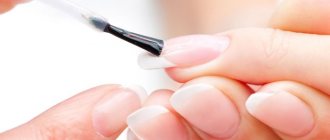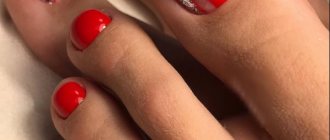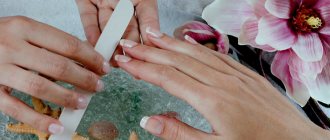All women who care about their appearance notice new trends in the beauty industry. Shellac is a relatively new gel polish that is quickly gaining popularity in salons, but few people know how durable such a pedicure is. How long the coating will last on the nails depends on a number of factors and mistakes made by the nail technicians, by eliminating which you can prolong the beauty of your feet.
What Shellac manufacturers say about gel polish pedicure
The durability of regular varnish is not long-lasting, but about Shellac they say that it can last on nails from two to four weeks. This difference depends on the quality of the material and application technique, conditions of use and the health status of the owner. If gel polish covers the fingernails, then the durability is significantly reduced compared to the feet.
Peeling of Shellac and rapid loss of shiny coating can occur for various reasons, so if after a pedicure you are going on a sea holiday, then you need to be ready to visit the salon in a few days.
View this post on Instagram
Posted by Unreel (@extremeofficial)
Pros and features of gel polish without a sticky layer
The finish for gel polish without a sticky layer is the choice of those who want to simplify the manicure procedure as much as possible. The top coat does not require additional treatment of the nail with a degreaser. You simply apply the topcoat and dry it in a lamp, after which you can do your homework. Since there is no additional purchase of a dehydrator, the overall cost of the manicure will be slightly lower.
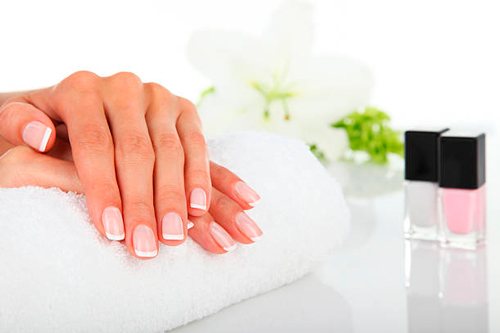
By choosing a fixer without a sticky layer, you save on manicure
The advantages of such products are manifested when working with small decorative elements. For example, when you use rhinestones and treat them with topcoat, you will not need to painstakingly remove a layer from each part.
Important! Those with thin nails should use the finish without a sticky layer with caution. The top is less elastic, so it may chip if your nails bend frequently.
But for those who have a strong nail plate, this top coat is a good choice, as it will provide maximum strength. This is confirmed by numerous reviews. Also, a finish without a sticky layer is used to design extended nails.
How to maintain the shine of Shellac for a pedicure
Toenails are subject to less mechanical stress than on hands, so a pedicure always lasts longer than a manicure. To maintain beauty at the proper level, you need to remember a few rules that will help maintain your coverage for a longer period.
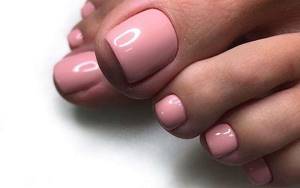
We exclude aggressive external factors
Beach lovers will have to get pedicures more often than usual. Ultraviolet radiation, moisture and sea salt negatively affect the coating. The water in the pool and bath with aromatic foams has the same unpleasant properties.
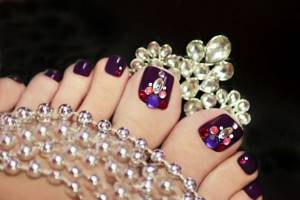
Choosing the right master
A professional at all stages of a pedicure uses products from only one manufacturer; if this is not the case, then the period of preservation of the original type of coating is sharply reduced. When you first visit a salon or a professional at home, you should pay attention to reviews that can tell you about the quality of their work. A self-respecting professional devotes no less time to the preparatory stage than to applying gel polish.
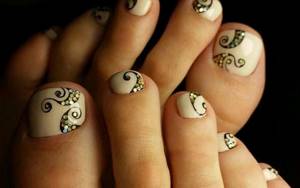
Only high quality materials
If the pedicure is done with an analogue and not the original Shellac, you should not expect long-term results. Preparing the nail and applying layers of gel polish should be done with means that are compatible with each other, and only professional masters know which one to choose.
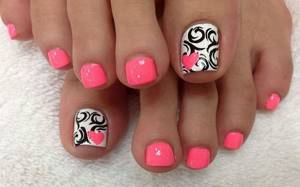
If you plan to do a pedicure yourself, it is recommended to buy application materials only in specialized stores.
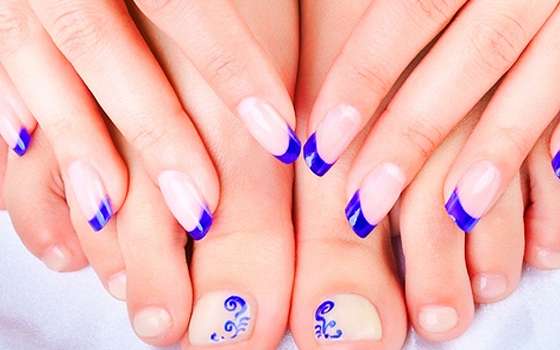
Original Shellac, even if applied independently, will retain its appearance for a month or more.
Fact about pedicure
Since caring for neglected feet manually requires a lot of effort, a more modern solution was required. In the 60s of the 20th century, the first pedicure cutters with sets of attachments appeared on sale.
Compliance with application technology
Any master knows that you should not steam your feet before applying Shellac gel polish, otherwise the disastrous result will manifest itself within a few days. It is also worth remembering that the color coating is applied in several thin layers, which are protected by a transparent fixing compound.
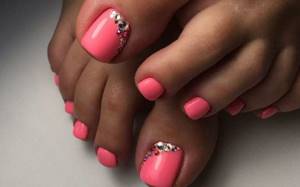
View this post on Instagram
Posted by Unreel (@extremeofficial)
The durability of Shellac gel polish coating directly depends on compliance with the application technology.
Monitoring the condition of your nails
Long-term preservation of the coating in ideal form directly depends on the general health of the owner of the pedicure. For example, if a woman’s hormonal levels change dramatically during pregnancy or menopause, then you shouldn’t expect long-term use from Shellac. Nails are a part of our body and when there is a malfunction in it, they begin to reject the foreign body and try to cleanse themselves of it.
If hormonal changes occur in a woman’s body, the coating may quickly peel off.
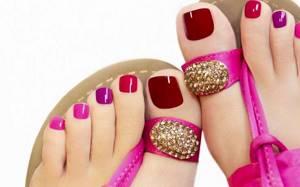
How to remove gel polish from nails
Gel polish removal must be done by a professional! Under no circumstances is it recommended to try to remove the coating by simply tearing it off or prying it with something! Otherwise, you risk removing the top layer of your nail along with the polish!
Gel polish can only be removed using a special remover. Apply it to a cotton pad, place it on the nail for a while and wrap it in foil to prevent air from penetrating and drying out the product. After just 15 minutes, you can gradually unwrap your fingers and wipe off any remaining coating from your nails with a cotton pad.
Gel polish remover is of course harmful, but given the short time that it is in direct contact with the nail under the foil, it does not have time to corrode it.
Gel polish lasts longer than usual, so its removal and application occurs in a shorter time interval. Accordingly, the nail is less likely to be processed, less likely to be injured, and less likely to come into contact with harmful liquids.
What are the contraindications when using Shellac for pedicure?
The components in the gel polish certainly protect the nail plate from damage, strengthen it and improve its external condition. The only reason to stop using Shellac is fungus. The disease must be treated, and not masked with a beautiful and spectacular coating. If there is the slightest manifestation of fungus, this is the right way to go to the doctor and buy medications, otherwise you can lose your nail and there will be no way to do a pedicure.
By contacting a professional master and eliminating negative factors that affect the coating, the pedicure will retain its original appearance for at least 3-4 weeks. And during this time you won’t have to be afraid to wear open shoes and sandals.
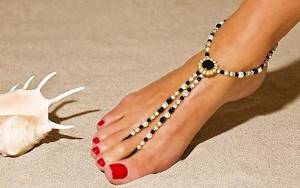
Reasons why shellac does not adhere well and chips at the tips of the nails
If the coating is applied correctly, in compliance with all requirements and the sequence of steps, shellac should last for at least two weeks - without peeling, chipping or other defects.
But sometimes the coating becomes unusable much earlier than the guaranteed period.
Why this happens, let's look at the possible reasons.
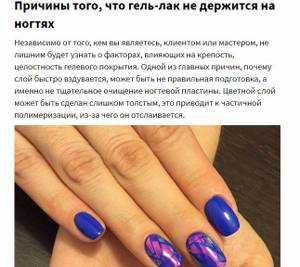
Mechanical damage
Oddly enough, women often forget that they have, in fact, glass on their nails, polymerized and frozen, but still fragile.
It cannot withstand significant mechanical loads.
The most common mechanical damage includes damage caused by active typing on the keyboard, or by accidental impact on a table or other hard surface. In addition, sometimes the nail can be damaged by a car door or even a refrigerator. Therefore, all manicurists strongly recommend being as careful as possible with this coating. Of course, don’t reach the point of fanaticism, but don’t forget that shellac is fragile on your nails. You can find out about Chanel mascara here.
If you have a habit of impatiently drumming your nails on the table, get rid of it quickly. If you often do this with shellac-coated nails, then no master will guarantee that the manicure will last two weeks. Most likely, much earlier the shellac will be covered with miniature cracks, and then it will slowly begin to chip.
Violation of technology
This reason happens when the manicurist did not fully study all the intricacies of applying shellac, or was careless, forgot to degrease the plate, or missed some of the stages of the three-phase system.
In the case of one of these reasons, the shellac will begin to move away from the plate quite soon; perhaps within a couple of days you will notice the first detachments at the cuticle.
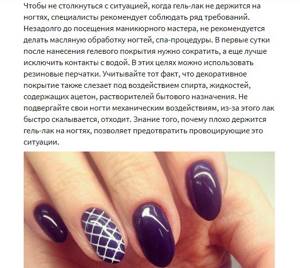
Exposure to chemicals
Some types of shellac are resistant to aggressive household detergents containing solvents, bleaches, and bleach.
Therefore, be careful when working with such compounds and wear gloves. In addition, in addition to shellac, this will also protect the delicate skin of your hands.
Nail condition
Many manicurists even refuse to apply shellac or dissuade the client from the procedure when they see that her nails are thin and too soft, with a layered structure.
On such nails, the coating usually does not last long. You can find out about L'Oreal Color Riche Mono shadows by following the link.
Poor quality materials
Sometimes a manicurist buys materials at a discount, or at sales, and may end up with a product that has expired or a low-quality counterfeit of an expensive brand.
As a result, it is not surprising that after a procedure carried out using such products, the coating refuses to adhere.
Hormonal surges
Shellac can fall off the nails for purely internal reasons of the client. Hormonal activity during pregnancy, taking OCs, medications for diabetes and other diseases can lead to material detachments.
Taking antibiotics can also negatively affect the condition of shellac nails, so be sure to keep this in mind.
The natural nail seems to reject the artificial coating, despite observing all stages of application and precautions.
Therefore, masters usually warn the client about a possible risk, explaining to her what could happen.
So that there is no “surprise” later when, a couple of days after the procedure, the coating begins to gently slide off the nails.
On video: why shellac doesn’t stick well on nails
We invite you to read in our article what shellac nails are.
Add folk recipes for strengthening your hair to your piggy bank here.
Look at the color palette of hair dye Concept
Mistakes of poor application on the nail, as the reason why shellac peels off and cracks
What mistakes when applying shellac can cause the material to peel off?
Poor preparation of the plate before the procedure. The preparation stage must be given no less attention than the actual application of the product. In particular, an incompletely removed pterygium can cause the gel polish on the nails to crack. The pterygium is the thin skin at the base of the nail. It can be removed only by high-quality treatment with a nail file or a special attachment on a manicure machine. The last way is the best.
Sometimes the artist forgets or does not consider it necessary to use a special primer before applying the base layer. And, indeed, many types of shellac exclude this stage.
However, experienced craftsmen say that even if the primer is not included in the procedure for applying this type of shellac, it is advisable to use it.
This product perfectly dries the plate, removes excess fat, dust and microscopic fluff that the degreaser could not cope with. Therefore, when applying a primer, the likelihood of shellac durability is much greater.
Degreasing the surface of the nails must be done with a special liquid, and not with nail polish remover or acetone. This can also affect the final result.
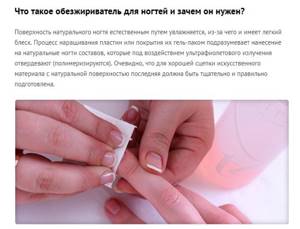
You cannot use regular cotton pads when applying shellac. In order to degrease the nail, you need special lint-free wipes or a sterile bandage.
These materials do not have lint, and a cotton pad will leave a bunch of hard-to-remove lint on the surface of the plate.
Do not forget that any speck can lead to detachments and material removal.
Poor drying can affect the final result. According to the rules, it is recommended to dry your nails for two minutes at each stage. Most UV lamps even have a special timer designed for exactly this time. However, sometimes drying occurs too quickly when the master or client is in a hurry, or, conversely, the nails are “overexposed” in the lamp. As a result, after some time, detachments can be observed.
Often, when applying shellac, such a simple but mandatory technique as sealing the end of the nail is forgotten.
Keep in mind that the end is sealed only with transparent materials: base and finish.
Colored gel polish is simply applied to the plate from above without smearing the edges. Sealing is necessary because it blocks access to air, liquids and, accordingly, microorganisms, to the space between the layers of material.
If the sealing is done well, nails with shellac will last a long time, and you don’t have to worry about contact with water.
Applying too thick layers of base, finish or color may result in them not drying completely in the lamp. The result is detachments.
Inaccurate application of shellac leads to it getting on the cuticle. In this case, the likelihood of early detachments is almost guaranteed. And for a complete look, you should pay attention not only to your nails, but also to your eyelashes, so your best choice would be to use Max Factor Masterpiece mascara or Pupa mascara.
In the video about errors in application and the reasons for the short wearing time of shellac
Tips to prevent shellac from chipping and coming off the nail plate
Some useful tips and tricks to help you avoid problems with shellac.
Pay special attention to preparing the nail plate before the procedure.
The natural nail must be thoroughly polished, degreased, and a primer must be applied to it.
If you skip or perform poorly one of these preparation stages, then material detachments are almost inevitable.
If your nails are thin and brittle, it is recommended that you first treat them before trying shellac.
Take a course of special vitamins with calcium, buy medicinal varnish, make paraffin baths for your hands at home.
Once the plate has hardened, you can begin the procedure with greater confidence, knowing that the coating will last a long time.
If you want to make shellac at home yourself, choose professional products rather than the popular “3 in 1”. Although the latter are cheaper, they do not guarantee quality results. But the three-phase system, tested by time and hundreds of masters, will cope with any nails much better and with higher quality. This also applies to mascara; you should choose a high-quality one, for example, L'Oreal Telescopic.
Try to purchase products from the same brand. This method will greatly reduce the risk of possible detachments. Products of the same brand are already suitable for each other, so using them is logical and profitable.
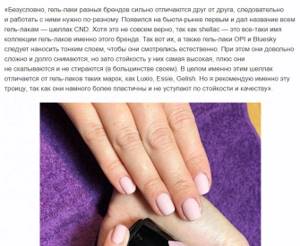
There is no need to shake bottles of products before applying shellac. Such shaking can lead to the appearance of air bubbles in the liquid, which is undesirable.
Be careful when applying shellac. There is no need to touch your nails while working, apply hand cream, oil - all this will lead to the appearance of greasy stains, which means that the next layer of material will no longer have high-quality adhesion (adhesion) to the surface.
Don't forget to check that the lamps in the UV device are working properly. If even one lamp out of four does not work, this may result in the coating not drying completely.
After the procedure is completed, it is not recommended to wet your nails for two hours. During this time, the shellac will finally polymerize. And then you can safely take water procedures without fear that water will get between the layers of coating.
If you have your nails done by a specialist, then wait for the correction, and do not start to shorten or file your shellac-coated nails yourself.
This in most cases leads to detachments and even sometimes to complete “sliding” of the material.
When planning to visit a salon, choose a good specialist. In this case, it is best to use the old proven method - word of mouth. Friends and work colleagues may well suggest and recommend their master, who is an excellent applicator of shellac. A recommendation from a good friend is the best guarantee of quality work.
After applying shellac, try to avoid contact with aggressive detergents. Avoid contact with chlorine-containing bleaches and solvents.
If such work cannot be avoided, wear gloves. You can find out about lipsticks from Pupa in this article.
Photo collection of the best works of pedicurists using Shellac gel polish
View this post on Instagram
Posted by Unreel (@extremeofficial)
How to apply top coat without sticky layer
The method of applying the coating will not differ fundamentally from that used for conventional gel polish.
Follow the following sequence of actions:
- File your nails and remove cuticles. Rub a lint-free cloth with degreaser over the surface of each nail. Use a primer if desired.
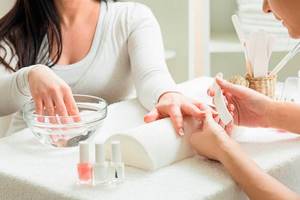
Nails need to be pre-treated
- Apply the base in a thin layer and dry. Drying time depends on what type of lamp is used.
- Apply 2 – 3 layers of colored gel polish. Dry each one in a lamp until it hardens.
- After this, you can apply gel polish without a sticky layer. Seal the end of each nail and cure in a lamp. After this, you can treat your fingers with cuticle oil.
No additional actions need to be taken. At first, this procedure may seem unusual to you, and you will be afraid to smear the sticky layer. However, you will quickly get used to the convenience of gel polish without a sticky layer and appreciate its advantages.
If you use a rub, the method of applying it depends on the specific product. In most cases, rubbing onto gel polish without a sticky layer is applied before drying. The top is convenient to apply, because in this case the rubbing does not roll into lumps, but forms a smooth, beautiful surface.
